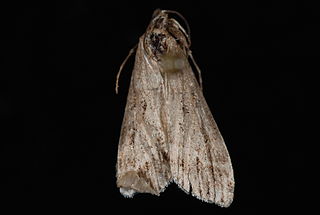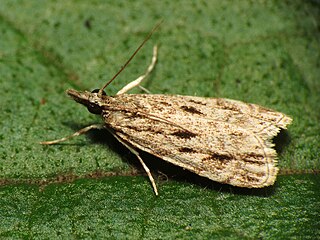
Eudonia is a large and widespread genus in the grass moth family (Crambidae), subfamily Scopariinae. There is no common name for the roughly 250 species placed here; new species are still being described regularly. Although the genus was proposed early in the 19th century, many of these moths were for a long time retained in Scoparia, the type genus of the subfamily and a close relative of Eudonia. A few small genera have been proposed for separation from Eudonia, but given the size of this group this is not particularly convincing; thus, all are retained here pending a comprehensive phylogenetic review.

Eudonia echo is a moth of the family Crambidae described by Harrison Gray Dyar Jr. in 1929. It is found in western North America from British Columbia to California.

Eupithecia spermaphaga is a moth in the family Geometridae first described by Harrison Gray Dyar Jr. in 1917. It is found in western North America from British Columbia, through Oregon and Washington to Nevada and California.
Cosipara tricoloralis, the tricolored cosipara moth, is a moth in the family Crambidae. It was described by Harrison Gray Dyar Jr. in 1904. It is found in North America, where it has been recorded from British Columbia, California, Colorado, Montana, Oregon and Washington.
Eudonia extincta is a moth in the family Crambidae. It was described by Harrison Gray Dyar Jr. in 1921. It is found in the Distrito Federal of Mexico.

Eudonia commortalis is a moth in the family Crambidae. It was described by Harrison Gray Dyar Jr. in 1921. It is found in North America, where it has been recorded from Alaska to British Columbia, Washington and California.

Eudonia albertalis is a moth in the family Crambidae. It was described by Harrison Gray Dyar Jr. in 1929. It is found in North America, where it has been recorded from Alberta to British Columbia, Washington, Idaho and Wyoming.
Eudonia excursalis is a moth in the family Crambidae. It was described by Harrison Gray Dyar Jr. in 1929. It is found in Costa Rica.
Eudonia inexoptata is a moth in the family Crambidae. It was described by Harrison Gray Dyar Jr. in 1929. It is found in Mexico.
Eudonia vinasalis is a moth in the family Crambidae. It was described by Harrison Gray Dyar Jr. in 1929. It is found in Costa Rica.
Eudonia ycarda is a moth in the family Crambidae. It was described by Harrison Gray Dyar Jr. in 1929. It is found in Guatemala and Orizaba, Mexico.
Eudonia expallidalis is a moth in the family Crambidae. It was described by Harrison Gray Dyar Jr. in 1906. It is found in North America, where it has been recorded from Washington to Nevada and California.
Eudonia schwarzalis is a moth in the family Crambidae. It was described by Harrison Gray Dyar Jr. in 1906. It is found in North America, where it has been recorded from Arizona.

Eudonia spaldingalis is a moth in the family Crambidae. It was described by William Barnes and James Halliday McDunnough in 1912. It is found in North America, where it has been recorded from Alberta, Arizona, British Columbia, California, Colorado, Montana, Nevada, New Mexico, Utah and Wyoming.

Eudonia strigalis, the striped eudonia moth, is a moth in the family Crambidae. It was described by Harrison Gray Dyar Jr. in 1906. It is found in North America, where it has been recorded from Nova Scotia to southern Ontario and south to Florida.
Eudonia torniplagalis is a moth in the family Crambidae. It was described by Harrison Gray Dyar Jr. in 1904. It is found in North America, where it has been recorded from South Dakota, the Rocky Mountains, the mountains of the south-western United States and from British Columbia to southern California.
Scoparia albipunctata is a moth in the family Crambidae. It was described by Herbert Druce in 1899. It is found in Costa Rica and Guatemala.
Scoparia denigata is a moth in the family Crambidae. It was described by Harrison Gray Dyar Jr. in 1929. It has been recorded from the US state of Arizona.
Scoparia palloralis is a moth in the family Crambidae. It was described by Harrison Gray Dyar Jr. in 1906. It is found in North America, where it has been recorded from British Columbia to southern California, Colorado and western Texas.
Scoparia ulmaya is a moth in the family Crambidae. It was described by Harrison Gray Dyar Jr. in 1929. It is found on the West Indies, where it has been recorded from Guadeloupe.







